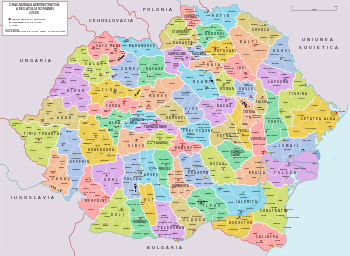Caliacra County
| Județul Caliacra | ||
|---|---|---|
| County (Județ) | ||
| ||
 | ||
| Country |
| |
| Historic region | Cadrilater | |
| Capital city (Reședință de județ) | Bazargic | |
| Established | After the Treaty of Bucharest (1913) | |
| Ceased to exist | Administrative and Constitutional Reform in 1938 | |
| Area | ||
| • Land | 4,500 km2 (1,700 sq mi) | |
| Population (1930) | ||
| • Total | 166,911 | |
| Time zone | EET (UTC+2) | |
| • Summer (DST) | EEST (UTC+3) | |
Caliacra was a county (județ) of Romania in the intewar period, in Southern Dobruja, with the seat at Bazargic (today Dobrich, Bulgaria).
Administration
The county consisted of 4 districts (plăși): Balcic, Casim, Ezibei (with the seat at Bazargic), and Stejarul. The county was neighbored by Constanța County to the north, Durostor County to the north-west, Black Sea to the east and the Kingdom of Bulgaria to the south.
History
The region was annexed by Romania as a result of the Balkan wars. Bulgaria managed to regain it between 1916 and 1918 (see Treaty of Bucharest (1918)), but then lost it again after the end of World War I (see Treaty of Neuilly).
After the 1938 Administrative and Constitutional Reform, the county was merged with the counties of Constanța, Durostor and Ialomița to form Ținutul Mării.
On September 7, 1940, the former county with the whole Southern Dobruja was returned to Bulgaria (see Treaty of Craiova).
Etymology
The county was named after the Cape of Caliacra (today Kaliakra, Bulgaria).
Coat of arms
The Coat of Arms depicted a shining lighthouse.
Population
According to the Romanian census of 1930 the population of Caliacra County was 166,911, of which 42.4% were ethnic Bulgarians, 23.0% Turks, 22.6% Romanians, 3.8% Gagauz, 2.7% Tatars, 1.4% Gypsies and 4.1% other ethnic groups: Greeks, Jews, Armenians, Circassians. Classified by religion: 70.4% Orthodox Christian, 28.2% Islam.
See also
External links
| Wikimedia Commons has media related to Interwar Caliacra County. |
- (in Romanian) Caliacra County on memoria.ro

